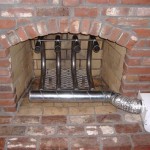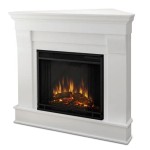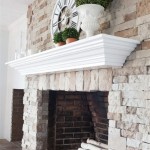Vintage Fireplace Mantels: A Timeless Focal Point
A fireplace often serves as the heart of a home, a gathering place that radiates warmth and comfort. The mantel, positioned above the firebox, enhances this focal point, providing an opportunity to showcase personal style and architectural detail. Vintage fireplace mantels, in particular, offer a unique charm and history, adding character and sophistication to any living space. Selecting and incorporating a vintage mantel requires consideration of various factors, including style, material, condition, and installation.
Vintage mantels represent a diverse range of design aesthetics, reflecting the architectural trends of different eras. From the ornate carvings of the Victorian period to the clean lines of the Art Deco movement, each style possesses distinct characteristics that can significantly impact the overall ambiance of a room. Understanding these stylistic variations is crucial when choosing a mantel that complements the existing décor or establishes a desired aesthetic.
Understanding Vintage Mantel Styles
Identifying the style of a vintage mantel involves recognizing the defining features associated with specific historical periods. Victorian mantels, prevalent from the mid-19th to early 20th centuries, are characterized by elaborate ornamentation, often incorporating intricate carvings, scrolls, and floral motifs. These mantels frequently feature rich, dark woods such as mahogany or walnut and may include decorative tiles surrounding the firebox.
In contrast, Art Deco mantels, popular from the 1920s to the 1940s, embrace geometric shapes, streamlined designs, and a sense of modernity. Materials commonly used in Art Deco mantels include marble, stone, and exotic woods, often accented with chrome or other metallic details. The focus is on sleekness and visual impact, creating a sophisticated and glamorous look.
Federal-style mantels, prevalent during the late 18th and early 19th centuries, display a more restrained elegance, drawing inspiration from classical architecture. These mantels typically feature symmetrical designs, fluted columns, and delicate carvings. Painted wood, often in white or cream, is a common characteristic of Federal-style mantels, reflecting a sense of refinement and balance.
Other notable styles include Craftsman, known for its simple, unadorned aesthetic and emphasis on natural materials like wood and stone; Gothic Revival, characterized by pointed arches, trefoil designs, and religious symbolism; and Mid-Century Modern, which emphasizes clean lines, minimalist forms, and a focus on functionality. Recognizing these styles allows homeowners to select a mantel that authentically reflects their personal taste and complements their existing architectural elements.
The materials used in the construction of a vintage mantel significantly influence its appearance, durability, and overall value. Common materials include wood, marble, stone, and cast iron, each offering distinct aesthetic and functional qualities.
Material Considerations for Vintage Mantels
Wood is a versatile and widely used material for fireplace mantels, offering a range of options in terms of color, grain, and texture. Hardwoods like oak, maple, and cherry are known for their durability and resistance to wear, while softwoods like pine and fir are often used for painted mantels. The type of wood selected influences the mantel's overall aesthetic and its ability to withstand the heat and moisture associated with a fireplace.
Marble is a luxurious and elegant material that adds a touch of sophistication to any fireplace. Available in a variety of colors and veining patterns, marble mantels are prized for their beauty and timeless appeal. Marble is also a relatively heat-resistant material, making it a practical choice for fireplace surrounds. However, marble is porous and susceptible to staining, requiring regular cleaning and sealing to maintain its pristine appearance.
Stone mantels, constructed from materials like granite, limestone, or slate, offer a rustic and natural aesthetic. Stone is a durable and heat-resistant material, making it an ideal choice for fireplaces. The texture and color variations of natural stone add visual interest and create a sense of warmth and authenticity. Stone mantels can be quite heavy, requiring careful planning and professional installation to ensure structural stability.
Cast iron mantels were prevalent during the Victorian era and offer a distinctive and ornate aesthetic. Cast iron is a durable and heat-resistant material, making it well-suited for fireplace surrounds. These mantels often feature intricate details and decorative motifs, adding a touch of historical charm to any room. However, cast iron is prone to rust and requires regular maintenance to prevent corrosion.
The condition of a vintage mantel is a critical factor to consider before purchase. While a certain degree of wear and tear is to be expected in older pieces, extensive damage or structural issues can significantly impact the mantel's value and its suitability for installation. Careful inspection is necessary to identify any potential problems and to assess the extent of any necessary repairs.
Assessing the Condition and Installation of a Vintage Mantel
Before purchasing a vintage mantel, it is crucial to thoroughly inspect it for any signs of damage or deterioration. Cracks, chips, and missing pieces can compromise the mantel's structural integrity and detract from its aesthetic appeal. Inspect joints and connections for looseness or instability, and check for signs of water damage or insect infestation.
Prior to installation, any necessary repairs should be addressed by a qualified professional. This may involve patching cracks, replacing missing pieces, or reinforcing weakened joints. Proper restoration ensures that the mantel is structurally sound and visually appealing.
Installation of a vintage mantel requires careful planning and attention to detail. The mantel must be securely attached to the wall, ensuring that it can support its own weight and any decorative items placed on it. Professional installation is recommended, particularly for heavy mantels or those with intricate designs. A qualified installer can ensure that the mantel is properly aligned and securely fastened, minimizing the risk of damage or injury.
Furthermore, adherence to local building codes and regulations is essential when installing a fireplace mantel. These codes typically specify minimum clearances between the mantel and the firebox, as well as requirements for fire-resistant materials. Compliance with these regulations ensures the safety and functionality of the fireplace.
By carefully considering the style, material, condition, and installation of a vintage fireplace mantel, homeowners can add a unique and timeless focal point to their living spaces. The historical charm and architectural detail of a vintage mantel can transform a room, creating a warm and inviting atmosphere that reflects personal style and appreciation for craftsmanship.

Antique Fireplace Mantel 70 X 100 The Door

Vintage Fireplace Mantel Recycling The Past Architectural Salvage

Diy Custom Fireplace Surround The Honeycomb Home

Antique French Limestone And Marble Fireplace Mantels For Interiors Historic Decorative Materials A Division Of Pavé Tile Wood Stone Inc

The Grower S Daughter Reclaimed Rustic Vintage Fireplace Mantel

29 Fabulous Antique Fireplace Ideas Shelterness

Gorgeous Mantel Victorian Fireplace Architectural Antiques Antique

18 Antique Fireplace Mantel Decor Ideas Ahna Fulmer

Antique Wood Marble Carved Fireplace Mantels Oley Valley Architectural Antiques

Antique Wood Marble Carved Fireplace Mantels Oley Valley Architectural Antiques
Related Posts








